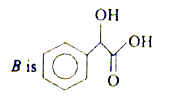An organic compound A(C4H6CI) on reation withNa/diethyl ether gives a hydrocarbon which on monochlorination gives only one chloro derivative A is .
t-butyl chloride
sec. butyl chloride
Iso butyl chloride
n-butyl chloride
The correct Answer is:A
To solve the question, we need to identify the organic compound A (C₄H₆Cl) that, when reacted with sodium in diethyl ether, produces a hydrocarbon which gives only one monochlorinated derivative.
1. Identify the Structure of Compound A:
The compound A has the molecular formula C₄H₆Cl. This suggests that it could be a chloroalkane. The presence of a chlorine atom indicates that it is likely a substituted alkane.
2. Consider Possible Structures:
The possible structures for C₄H₆Cl include:
- Tertiary butyl chloride (C(CH₃)₃Cl)
- Secondary butyl chloride (C₂H₅CHClCH₃)
- Isobutyl chloride (C₃H₇CH₂Cl)
- Normal butyl chloride (C₃H₇CH₂Cl)
3. Reaction with Sodium in Diethyl Ether:
The reaction of alkyl halides with sodium in diethyl ether is known as the Wurtz reaction. This reaction typically leads to the formation of alkanes.
4. Analyze Each Option:
- Tertiary butyl chloride:
- Structure: (CH₃)₃CCl
- Wurtz Reaction: (CH₃)₃CCl + 2 Na → C₄H₁₀ + 2 NaCl
- Result: Produces a hydrocarbon (C₄H₁₀) which has a plane of symmetry and thus can only yield one monochlorinated derivative.
- Secondary butyl chloride:
- Structure: CH₃CHClCH₂CH₃
- Wurtz Reaction: Produces a hydrocarbon that has different types of hydrogen atoms leading to multiple monochlorinated derivatives.
- Isobutyl chloride:
- Structure: (CH₃)₂CHCH₂Cl
- Wurtz Reaction: Produces a hydrocarbon that also has different types of hydrogen atoms leading to multiple monochlorinated derivatives.
- Normal butyl chloride:
- Structure: CH₃CH₂CH₂CH₂Cl
- Wurtz Reaction: Produces a hydrocarbon that has different types of hydrogen atoms leading to multiple monochlorinated derivatives.
5. Conclusion:
The only compound that gives one monochlorinated derivative upon chlorination is tertiary butyl chloride (C(CH₃)₃Cl).
Final Answer:
The compound A is tertiary butyl chloride.
---
The compound A has the molecular formula C₄H₆Cl. This suggests that it could be a chloroalkane. The presence of a chlorine atom indicates that it is likely a substituted alkane.
The possible structures for C₄H₆Cl include:
- Tertiary butyl chloride (C(CH₃)₃Cl)
- Secondary butyl chloride (C₂H₅CHClCH₃)
- Isobutyl chloride (C₃H₇CH₂Cl)
- Normal butyl chloride (C₃H₇CH₂Cl)
The reaction of alkyl halides with sodium in diethyl ether is known as the Wurtz reaction. This reaction typically leads to the formation of alkanes.
- Tertiary butyl chloride:
- Structure: (CH₃)₃CCl
- Wurtz Reaction: (CH₃)₃CCl + 2 Na → C₄H₁₀ + 2 NaCl
- Result: Produces a hydrocarbon (C₄H₁₀) which has a plane of symmetry and thus can only yield one monochlorinated derivative.
- Secondary butyl chloride:
- Structure: CH₃CHClCH₂CH₃
- Wurtz Reaction: Produces a hydrocarbon that has different types of hydrogen atoms leading to multiple monochlorinated derivatives.
- Isobutyl chloride:
- Structure: (CH₃)₂CHCH₂Cl
- Wurtz Reaction: Produces a hydrocarbon that also has different types of hydrogen atoms leading to multiple monochlorinated derivatives.
- Normal butyl chloride:
- Structure: CH₃CH₂CH₂CH₂Cl
- Wurtz Reaction: Produces a hydrocarbon that has different types of hydrogen atoms leading to multiple monochlorinated derivatives.
The only compound that gives one monochlorinated derivative upon chlorination is tertiary butyl chloride (C(CH₃)₃Cl).
The compound A is tertiary butyl chloride.
Similar Questions
An organic compound A(C4H9Cl) on the reaction with Na/diethly ether gives a hydrocarbon which on monochlorination gives only one chloro derivative then, A is
View SolutionAn aromatic compound (A),C8H10, on oxidation with acidic KMnO4 gives dibasic acid. The compound (A) on nitration gives three isomeric nitro derivatives. The compound (A) is:
View Solution
Knowledge Check
An organic compound C4H6 on reductive ozonolysis gives HCHO,CO2andCO3CHO. Find structure of compound.
AH2C=CH−CH=CH2BCH3−CH=C=CH2C DH3C−C≡C−CH3
DH3C−C≡C−CH3Which one of the following compounds give only one isomer upon nitration ?
A B
B C
C D
D
Compound (A) C8H6O2 on treatment with aq. NaOH followed by acidification gives (B) C3H2O3 which on oxidation gives benzoic acid only:
A B
B C
C D
D
A hydrocarbon with formula C8H18 gives one monochloro derivative. The hydrocarbon can be:
View SolutionAn organic compound A (C2H6O) reacts with sodium to form a compound B with the evolution of H2 and gives a yellow compound C on reacting with iodine and NaOH. When heated with conc. H2SO4 at 413 K, it gives a compound D (C4H10O) which on reaction wiht conc. HI at 373 K gives compound E. The compound D is also obtained when B is heated with E. Idntify the compounds A,B,C,D and E write the equations for the reaction involved.
View SolutionAn organic compound (A) (C6H10O) on reaction with CH3MgBr followed by acid treatment gives compound (B). The compound (B) on ozonolysis gives compound (C ), which in the presence of a base gives 1-acetyl cyclopentene (D). The compound (B) on reaction with HBr gives compound (E ). Write the structures of (A), (B), (C ), (D), and (E ). Show how (D) is formed from (C ).
View SolutionA compound P(C5H6) gives positive Bayer test and on hydrogentation from a hydrocarbon B(C5H10) which gives only monochloro product. The compound 'P' is.
View SolutionAn organic compound X(C4H8O2) gives positive test with NaOH and Phenopthalein. Structure of X will be:
View Solution
